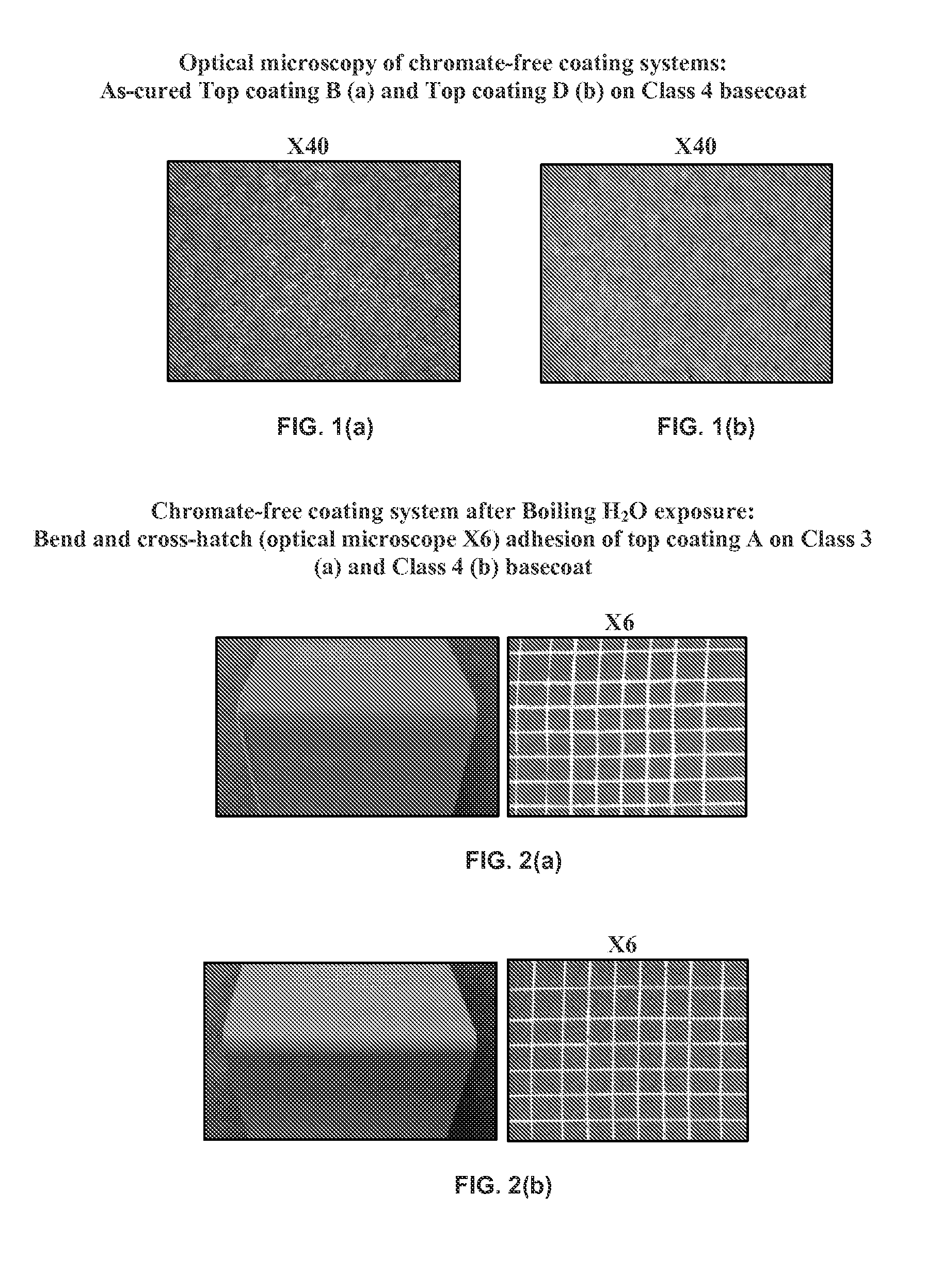Chromate-free ceramic coating compositions
a technology of chromate-free ceramic coating and slurry, which is applied in the direction of superimposed coating process, water-setting substance layered product, coating, etc., can solve the problems of red rust of coatings, significant increase of parts, and inability to maintain the basecoat slurry as a “one-part” solution, etc., to achieve superior corrosion and heat resistance
- Summary
- Abstract
- Description
- Claims
- Application Information
AI Technical Summary
Benefits of technology
Problems solved by technology
Method used
Image
Examples
example 1
[0073]Top coating slurry A from Table 2 was prepared by mixing of 24 grams of Cr2O3 green pigment and 2 grams of Cab-O-Sil® M5 fumed silica into 200 grams of aluminum phosphate binder with a molar ratio Al:PO4=2.7 and pH=1.8. The binder also contained 3.5 grams of B2O3. Slurry A also had a final pH=1.8, with the pigment particle size in the slurry being characterized as D50 of about 5 micron and D90 of about 8 micron.
[0074]Prior to the application of the top coating, a step of burnishing the basecoat with Al2O3 abrasive media (to activate the basecoat and thus to make it sacrificially protective against corrosion) was carried out. The burnishing was carried out by two different routes. A first group of the panels was burnished after the first cured layer of the basecoat (i.e. Class 3 activated basecoat). A second group of panels was burnished after the second cured layer of the basecoat (Class 4 activated basecoat). After formation of the Class 3 and Class 4 activated basecoats, the...
examples 2-3
[0078]In Example 2, the top coating Slurry B from Table 2 was prepared by mixing of 24 grams of Cr2O3 green pigment and 2 grams of Aeroxide® fumed TiO2 into 200 grams of aluminum phosphate binder with a molar ratio Al:PO4=1: 2.4 and pH=1.47. The binder also contained 3.0 gram of B2O3 . Slurry B had a final pH =1.5 with the pigment particle size in the slurry characterized as D50 of about 4.0-4.5 micron, and D90 of about 8 microns. The slurry B was spray applied on the surface of the chromate-free basecoat; the burnishing step with Al203 grit was performed after the second cured layer of the basecoat. The sprayed layer of Slurry B was dried at 175° F. for 15 minutes and then cured at 650° F. for 30 minutes followed by post-curing at 1000° F. for 60 minutes. Total thickness of the basecoat+top coat B coating system was determined to be in the range from 1.4 to 1.7 mils, with the basecoat having a thickness of 1.2-1.5 mils and the top coating have a thickness of 0.1-0.3 mils. The coati...
example 4
[0086]Example 4 serves to illustrate influence of Al:PO4 molar ratio of the aluminum phosphate based binder of the top coating slurry on the overall functional performance of chromate-free coating systems of the present invention. Top coating Slurry C from Table 2 was prepared by mixing of 18 grams of titanium dioxide white pigment TiO2 and 2 grams of Aeroxide® fumed TiO2 into 200 grams of aluminum phosphate binder with molar ratio Al:PO4=1:2.7; the binder also contained 3.0 gram of B2O3. Slurry C had a final pH =1.8 with the pigment particle size in the slurry being characterized as D50 of about 3.0 micron and D90 of about 4.5 micron. The slurry C was spray applied on the surface of the chromate-free basecoat. A burnishing step with Al203 grit was performed after the second cured layer of the basecoat. The sprayed layer of Slurry C was dried at 175° F. for 15 minutes and then cured at 650° F. for 30 minutes. Total thickness of the basecoat+top coat C coating system was determined t...
PUM
| Property | Measurement | Unit |
|---|---|---|
| particle size distribution | aaaaa | aaaaa |
| particle size distribution | aaaaa | aaaaa |
| particle size distribution | aaaaa | aaaaa |
Abstract
Description
Claims
Application Information
 Login to View More
Login to View More - R&D
- Intellectual Property
- Life Sciences
- Materials
- Tech Scout
- Unparalleled Data Quality
- Higher Quality Content
- 60% Fewer Hallucinations
Browse by: Latest US Patents, China's latest patents, Technical Efficacy Thesaurus, Application Domain, Technology Topic, Popular Technical Reports.
© 2025 PatSnap. All rights reserved.Legal|Privacy policy|Modern Slavery Act Transparency Statement|Sitemap|About US| Contact US: help@patsnap.com



